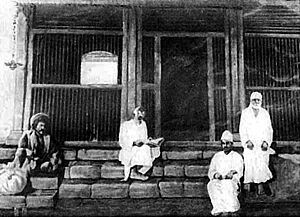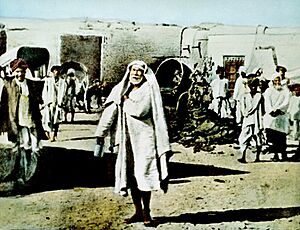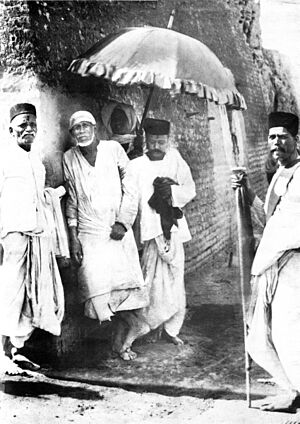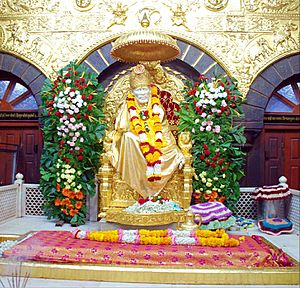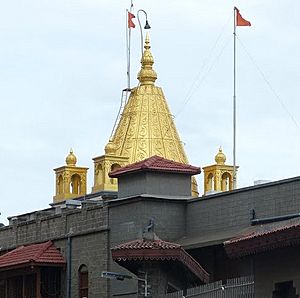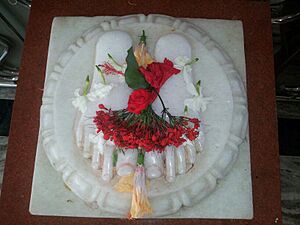Sai Baba of Shirdi facts for kids
Quick facts for kids Sai Baba |
|
|---|---|
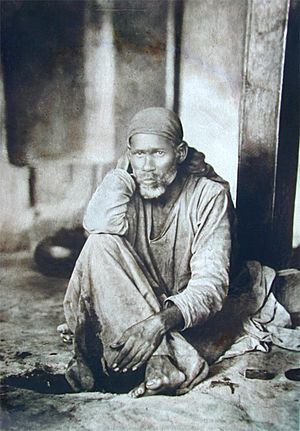
Sai Baba (photograph before 1918)
|
|
| Died | 15 October 1918 Shirdi, Bombay Presidency, British India (present-day Ahmednagar District, Maharashtra, India) |
| Resting place | Samadhi Mandir, Shirdi |
Sai Baba of Shirdi (born around 1838, died October 15, 1918) was a very respected spiritual teacher in India. Many people, both Hindus and Muslims, saw him as a saint. He was also known as Shirdi Sai Baba.
Sai Baba taught people to understand themselves better. He said it was important to focus on inner peace, not on things that don't last. His main lessons were about love, forgiveness, helping others, and being happy with what you have. He also taught about being devoted to God and your spiritual teacher (Guru). He believed that a true Satguru (spiritual guide) could help you grow spiritually.
Sai Baba did not like it when people were treated differently because of their religion or social group. It's not clear if he was Muslim or Hindu, but this didn't matter to him. His teachings mixed ideas from both Hinduism and Islam. For example, he called the mosque where he lived Dwarakamayi, which is a Hindu name. He also used rituals and stories from both religions.
Some of his favorite sayings were: "Look to me, and I shall look to you" and "Allah tera bhala karega" (meaning: God will bless you). Many followers believe he was a form of the Hindu god Dattatreya.
Template:TOC limit=3
Contents
Sai Baba's Life Story
Most of what we know about Shirdi Sai Baba comes from a book called Shri Sai Satcharitra. A follower named Hemadpant wrote it in 1922. The book shares stories from many different followers and what Hemadpant saw himself. Another follower, Sri Narasimha Swamy, also wrote a book called Life of Sai Baba.
His Early Life
We don't know exactly when or where Shirdi Sai Baba was born. Some clues suggest he was born near Shirdi in Maharashtra, India. Some stories say he was born in a small village called Pathri. His parents might have been a boatman named Ganga Bhavadia and his wife Devagiriamma. Other stories say he was born in Tamil Nadu, with parents named Vaishnavdevi and Abdul Sattar.
Baba often gave confusing answers about his past. He said it wasn't important. He once told a close follower that he was born to Hindu parents. He said he was then cared for by a Muslim fakir (a holy person). Other stories say the fakir's wife left him with a Hindu teacher, Venkusa of Selu. Baba supposedly stayed with Venkusa for 12 years.
Baba arrived in the village of Shirdi when he was about 16 years old. He stayed there for three years, then left for a year. He came back for good around 1858, after the Indian Rebellion of 1857. This makes people think he might have been born in 1838. When he first arrived, he lived a simple life. He sat quietly under a neem tree and meditated.
Some villagers who were religious visited him often. But children sometimes thought he was strange and threw stones at him. After a while, he left Shirdi again. We don't know where he went or what he did. Some say he met many saints and worked as a weaver. He also reportedly said he fought with the army of Rani Lakshmibai during the 1857 rebellion.
How He Got His Name
Sai Baba's real name is unknown. The name Sai was given to him by a temple priest when he returned to Shirdi in 1858. Sai means a religious beggar, but it can also mean God. The word Baba means grandfather, father, or sir in many languages. So, Sai Baba means "holy father" or "saintly father."
Coming Back to Shirdi
When Sai Baba returned to Shirdi, he started wearing a long, knee-length Kafni robe and a cloth cap. Before this, he was said to look like an athlete with long hair. He changed his clothes after losing a wrestling match. This new clothing made some people think he was a Muslim holy man. This caused some problems at first in the village, which was mostly Hindu.
For several years, Baba lived under a neem tree and spent a lot of time meditating. He was quiet and often walked alone in the jungle. Eventually, he moved into an old, broken-down mosque. He lived there by himself, asking for alms (food or money) and meeting visitors. In the mosque, he kept a special fire called a dhuni. He gave sacred ash (called 'Udi') from this fire to people when they left. People believed this ash had healing powers.
He also acted like a local doctor, treating the sick with the ash. He taught spiritual lessons to his visitors. He told Hindus to read the Ramayana and Bhagavad Gita. He told Muslims to read the Quran. He always said it was important to remember God's name. He often used stories and parables to explain his ideas.
Baba also took care of a garden called Lendi Baug. It was named after a small river nearby. This garden still exists today. It has small temples dedicated to people and animals connected to Baba's life. Many pilgrims still visit it.
Some of Sai Baba's followers became famous spiritual leaders themselves. These include Mahalsapati and Upasani Maharaj. Other saints also respected Sai Baba. In 1910, Sai Baba's fame grew in Mumbai. Many people came to see him because they believed he could perform miracles. They even built his first temple in Bhivpuri.
His Final Years and Passing
In August 1918, Shirdi Sai Baba told his followers that he would soon leave his body. In late September, he got a high fever and stopped eating. As he became weaker, he asked his followers to read holy books to him. He still met visitors. He passed away on October 15, 1918. This was the same day as the Vijayadashami festival that year. His body was buried at Buti Wada in Shirdi. This place is now a temple called Shree Samadhi Mandir or Shirdi Sai Baba Temple.
Sai Baba's Teachings
Sai Baba was against any unfair treatment based on religion or social group. He did not like strict religious rules, whether they were Christian, Hindu, or Muslim.
Sai Baba encouraged his followers to pray, chant God's name, and read holy books. He told Muslims to study the Quran and Hindus to study books like the Ramayana and Bhagavad Gita. He taught his followers to live a good life, help others, and love all living things. He also stressed two important qualities: faith (Shraddha) and patience (Saburi). He did not believe in atheism.
In his lessons, Sai Baba taught that you should do your duties without being too attached to worldly things. He also taught to be happy no matter what happens. In his own life, he followed some Muslim worship practices. He allowed Muslim prayers and Qur'an readings during festivals. He enjoyed listening to religious songs accompanied by music.
Sai Baba explained religious texts from both Islam and Hinduism. He explained Hindu scriptures in a way that focused on devotion to God (bhakti). His teachings were influenced by different Hindu spiritual paths like devotion, knowledge, and selfless action.
Sai Baba encouraged people to be generous and share with others.
Worship and Followers
A local priest named Mhalsapati Nagre is thought to be Sai Baba's first follower. In the 1800s, Sai Baba had only a small group of followers from Shirdi and other parts of India.
Today, Shirdi is a very important place in India because of Sai Baba. It is a major Hindu pilgrimage site. The first Sai Baba temple was built in 1922 in Kudal.
The Sai Baba Temple in Shirdi gets about 25,000 visitors every day. During religious festivals, this number can go up to 100,000. The temple's inside and outside top are covered in gold. Inside, there is a statue of Sai Baba made of Italian marble. It wears royal clothes, a gold crown, and fresh flowers. The Shri Sai Baba Sansthan Trust manages the temple.
Following old traditions from when Baba was alive, four daily prayers (Aarti) are held inside the Samadhi Mandir:
- Kakad Aarti (Morning Prayer) at 4:30 AM
- Madhyan Aarti (Afternoon Prayer) at 12:00 PM
- Dhup Aarti (Evening Prayer) at 6:30 PM
- Shej Aarti (Night Prayer) at 10:30 PM
Every Thursday, a procession with Sai Baba's palanquin (a covered chair carried by poles) takes place. It goes from the Samadhi Mandir to Dwarkamayi, then to Chavdi, and back to the temple. People of all faiths are welcome to visit the Samadhi Mandir and eat free meals at the Prasadalaya.
Sai Baba of Shirdi is especially honored in the Indian states of Maharashtra, Odisha, Andhra Pradesh, Telangana, Karnataka, Tamil Nadu, and Gujarat.
The movement of Shirdi Sai Baba's followers started in the 1800s. In recent years, it has spread to many countries around the world.
Hindus and Muslims
Baba often spoke about Hindu gods and quoted from Hindu holy books. He would explain parts of the Bhagavad Gita and other texts. The names of Krishna and Rama were sacred to him. With Muslim followers, he spoke of Allah and the Koran, often quoting Persian verses. He often said, "Allah rakhega vaiia rahena" ("Let us be happy with what we have, and give our will to Allah"). He told his listeners that he was just a humble follower of Allah, like them. Later, people from other religions, like Parsis and Christians, also visited him. He respected all faiths. He taught that all religions are different paths to the same great goal.
His idea that all people are one family fit well with both Hindu and Sufi beliefs. These beliefs say that God is one and that all living things are part of one big family. For Sai Baba, all paths were equally good. He believed "Ishwar" (the Hindu God) and "Allah" were the same. People who visited him were amazed to see Hindus, Muslims, and others living together so peacefully. This often changed their lives and beliefs.
His Followers
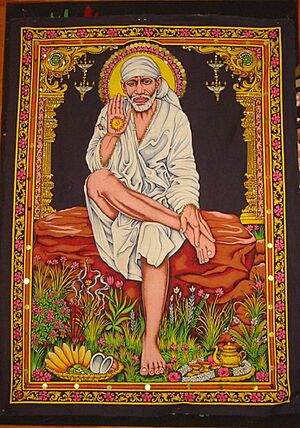
Shirdi Sai Baba did not choose anyone to take his place after he died. He also did not formally train any disciples, even when asked. Some of his well-known followers included Mahalsapathi, Madhav Rao (Shama), and Lakshmi Bai. Some followers, like Upasani Maharaj, became famous spiritual leaders. After Sai Baba's death, his followers even offered daily prayers to Upasani Maharaj when he visited Shirdi.
Hindus
The Hindu saint Anandanath called Sai Baba a "precious diamond." Another saint, Gangagir, said "Blessed is Shirdi, that it got this precious jewel." Sri Beedkar Maharaj greatly respected Sai Baba. He gave him the title Jagad guru (world teacher) in 1873. Sai Baba was also respected by Vasudevanand Saraswati. A group of yogis (Hindu spiritual practitioners) also honored him. Many people see him as a form of God, a true spiritual teacher, or a saint. This is common in Hinduism, where people have different ways of understanding God.
Muslims
Abdul Baba was a close follower of Sai Baba. He took care of Sai Baba's shrine from 1918 to 1922. Many Muslim followers visited the shrine until the 1980s.
Parsis
Sai Baba was also respected by important Zoroastrians like Nanabhoy Palkhivala and Homi J. Bhabha. He is often called the most popular non-Zoroastrian religious figure among Zoroastrians.
Meher Baba, who was born into a Zoroastrian family, met Sai Baba in December 1915. This meeting was very important in Meher Baba's life. While Sai Baba's life story doesn't mention Meher Baba, Meher Baba's life story talks a lot about Sai Baba.
Meher Baba said that his own spiritual journey was influenced by Upasani, Sai Baba, and three other great spiritual teachers. He called Sai Baba a Qutub-e-Irshad, which means a "Master of the Universe" in a spiritual ranking system used by Meher Baba's followers.
Reported Miracles
Sai Baba's followers say he performed many miracles. These include being in two places at once, floating in the air, reading minds, making things appear, and curing sick people. They also say he could light lamps with water and appear to be hurt when someone else was hurt. During special sightings (Darshan), he appeared to people as different Hindu gods, depending on their faith.
His followers also believe he appeared to them in their dreams and gave them advice. Many people have written down their experiences with these miracles.
Sai Baba in Culture
Art and Buildings
There are many temples dedicated to Shirdi Sai Baba in India. Temples are also found in other countries, including the United States, Trinidad and Tobago, Guyana, Fiji, Mauritius, South Africa, Netherlands, Canada, Australia, and the United Kingdom. In the mosque in Shirdi where Sai Baba lived, there is a life-size painting of him by an artist from Mumbai. There are also many statues of Sai Baba. One famous marble statue is in the Samadhi Mandir in Shirdi, where he was buried.
In 2008, India Post released a special postage stamp to honor Shirdi Sai Baba.
Movies and TV Shows
Sai Baba has been the subject of many movies in different Indian languages.
| Year | Film | Title role | Director | Language |
|---|---|---|---|---|
| 1955 | Shirdi Che Sai Baba | Dattopant Aangre | Kumarsen Samarth | Marathi |
| 1977 | Shirdi Ke Sai Baba | Sudhir Dalvi | Ashok V. Bhushan | Hindi |
| 1986 | Sri Shirdi Saibaba Mahathyam | Vijayachander | K. Vasu | Telugu |
| 1989 | Bhagavan Shri Sai Baba | Sai Prakash | Sai Prakash | Kannada |
| 1993 | Sai Baba | Yashwant Dutt | Babasaheb S. Fattelal | Marathi |
| 1999 | Maya / Guru Poornima / Jayasurya | Rama Narayanan | Tamil Telugu Kannada |
|
| 2000 | Sri Sai Mahima | Sai Prakash | Ashok Kumar | Telugu |
| 2001 | Shirdi Sai Baba | Sudhir Dalvi | Deepak Balraj Vij | Hindi |
| 2005 | Ishwarya Avatar Sai Baba | Mukul Nag | Ramanand Sagar | Hindi |
| 2010 | Malik Ek | Jackie Shroff | Deepak Balraj Vij | Hindi |
| 2010–11 | Bhagwan Sri Shirdi Sai Baba | Surya Vasishta | Bukkapatna Vasu | Kannada |
| 2012 | Shirdi Sai | Nagarjuna Akkineni | K. Raghavendra Rao | Telugu |
| 2017–Present | Mere Sai | Abeer Soofi | Sachin P. Ambre Harsh Agarwal |
Hindi |
Images for kids
See also
 In Spanish: Sai Baba de Shirdi para niños
In Spanish: Sai Baba de Shirdi para niños
- List of Hindu gurus and saints
- Shirdi Sai Baba movement


